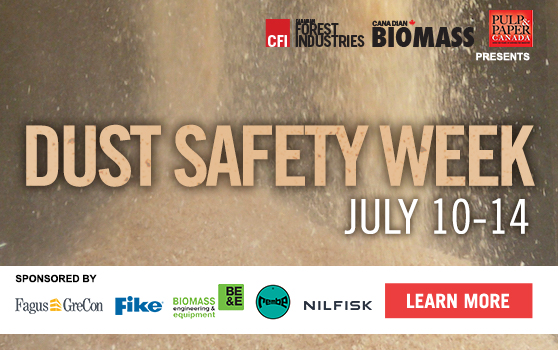
Here’s what we learned during Dust Safety Week 2023
July 14, 2023
By Canadian Biomass staff

For the seventh year in a row, Canadian Biomass, Canadian Forest Industries and now Pulp & Paper Canada turned the spotlight on wood dust with our annual Dust Safety Week. Over the past five days, we’ve shared on our website and social channels (#DustSafetyWeek) new and archived content from our partners to highlight best practices when it comes to dust management in forest products manufacturing facilities.
Here’s a snapshot of what we learned during the week:
Process safety principles: WorkSafeBC’s Alexandra Skinner wrote about process safety in wood manufacturing, which involves managing risks by implementing effective controls to prevent and mitigate the risks associated with fires, explosions, leaks, spills, equipment problems, corrosion, component failures, and unexpected situations.
Complying with changing requirements: Michael Summers with Nilfisk shared five steps that manufacturers can implement immediately to keep up with changing combustible dust regulations for the protection of their employees, facilities and productivity.
Building a combustible dust program: Bill Laturnus with the BC Forest Safety Council explained how the province’s sawmilling industry has been developing strategies to minimize the potential for catastrophic wood dust explosions in their operations, leading to the creation of a sustainable and effective combustible wood dust program.
Wood hogger fires: DustEx Research’s Chris Cloney reviewed the incidents that inspired a BC Forest Safety Council and Manufacturing Advisory Group (MAG) safety alert about a smouldering fire in a hogging machine, along with the subsequent investigation and safety recommendations from WorkSafeBC.
Explosion protection solutions: Fike explosion protection global product manager Jim Vingerhoets explains how reliable protection systems – either passive or active – can mitigate the potential catastrophic consequences of a dust explosion.
We also shared news of a new, free e-learning platform for operators launched by the Wood Pellet Association of Canada and the BC Forest Safety Council that has a combustible dust focus, as well as an archived article from Pulp & Paper Canada in which Luc Cormier explains that the best way for pulp and paper operations to assess the hazards and ensure adequate safeguards are in place is to perform a dust hazard analysis.
Today is the final day of Dust Safety Week 2023, but we’ll continue to share archived new content throughout the year, housed on the Dust Safety Week landing page.
We’d like to once again thank this year’s Dust Safety Week sponsors for making it all possible: Biomass Engineering & Equipment, Fagus GreCon, Rembe, Fike and Nilfisk.
This article is part of Dust Safety Week 2023. To read more articles on dust safety, click here.
Print this page